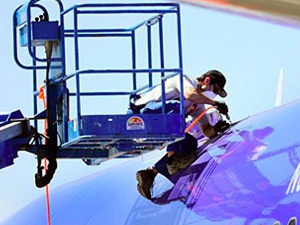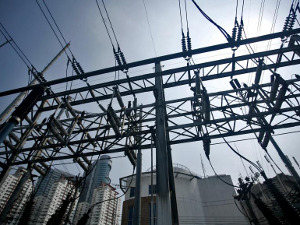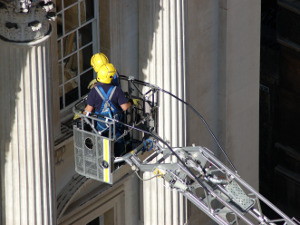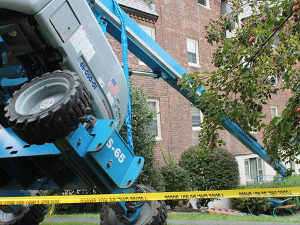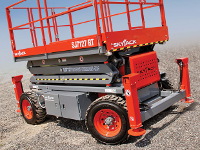Exiting from platforms at height
Walking off mobile platforms at height is generally prohibited. Is it always? What is the practice? This is an issue currently faced by, among others, companies installing and servicing cranes. In a series of two articles, the authors will take a closer look at what this looks like in practice and in light of the legal and OHS.

Photo Haulotte
Some have certainly seen a scene in which several service technicians put together the so-called Warsaw scaffolding, and after assembly, it enters the damaged crane bridge. It happened in the 90s. At that time, however, it was a rather rare case, because the existing halls were equipped with longitudinal galleries, which allowed for safe entry to the track, and then to the crane bridge at any point of its stopping. Along with the increase in investments, a trend, generally popular in Western countries, appeared, consisting in the elimination of galleries along the track, especially in situations where the level of the track did not exceed the height of 6 m. This significantly reduced the investment costs. Access to the operation and maintenance of cranes was secured by purchasing a slow-moving mobile platform, which was used to operate many cranes and perform all the works necessary for maintenance. For 25 years, these solutions have dominated the design of the hall structures and resulted in the elimination of platforms from double-girder cranes installed in low-height halls. Along with them, however, another problem appeared in companies assembling and servicing cranes: How to safely enter the crane bridge or the subgrade from the mobile platform? not allowed. It is hardly surprising, because mass-produced platforms must limit the spectrum of threats to foreseeable situations.
Construction companies using platforms for construction and assembly works in their OHS instructions prohibit work in inclination outside the basket, and if such a need arises, the employee must be equipped with individual fall protection equipment and indicate anchoring points.
The vast majority of manufacturers of mobile platforms do not take into account the possibility of leaving the basket in their design solutions. Climbing over the protective railings of the basket increases the risk even more. Dynamic introduction of load on the side of the cage may generate a torsional moment, which may lead to the boom twisting or loss of platform stability. Another problem is the behavior of the hydraulic system in the event of dynamic loads.
The Technical Supervision Authority is of the opinion that the device should be used in accordance with its intended purpose. Therefore, if the manufacturer clearly indicates in the operation and maintenance documentation that leaving the platform is not allowed, it means that this recommendation should be followed.
In practice, however, there are a number of situations in which the exit from the mobile platform is often the only or the safest solution. They are, for example:
- levacating people from balconies during a fire (performed by the fire brigade with a mobile platform dedicated to such actions);
- evacuation of an employee who suffered an accident on an overhead crane at a height of several meters, and local fire brigades do not have special trucks with a platform;
- evacuation of the operator from the crane's cabin, who has fainted and the mobile platform is the only means at his disposal;
- entering the crane bridge during assembly or service activities;
- entrance to the crane gallery in order to remove the failure;
- going out onto the roof of the building during roofing works.
So what can and should be done to avoid unfortunate accidents when entering / exiting the bin in the future?
It is worth taking advantage of the knowledge and experience of other European countries, such as Great Britain, Germany, Italy, Switzerland and Austria, which have faced this problem. In the next article, the legal conditions used by these countries will be analyzed. Then, approximate new solutions that provide for the possibility of leaving the basket and returning to the raised position of the mobile platform, provided that certain specific rules are followed. The author of this part will be Rafał Knotek-Trościanko, Training Manager at Ergon Personnel Training Center.
Mobile platforms are devices from the group of cranes that are subject to the act on technical inspection. Therefore, they are subject to acceptance tests, periodic and ad hoc technical supervision, and their operation is possible after obtaining the approval for operation. The act on technical inspection requires the operating and maintenance personnel to have qualification certificates for the operation and maintenance of mobile platforms. In order to obtain them, applicants must pass an exam consisting of theoretical and practical parts before the committee of the Office of Technical Inspection. Repairs and modernization of mobile platforms may only be performed by plants authorized by the Office of Technical Inspection.
The list of the most frequently identified threats resulting from the non-compliance of the mobile access platform with the requirements is included in the Regulation of the Minister of Economy of October 30, 2002. On the minimum requirements for occupational health and safety in the use of machines by employees at work (Journal of Laws No. 191, item 1596) , as amended).
 General recommendations and procedures for exiting the platform basket at height have been developed by the International Federation of Producers and Users of Lifting Equipment (IPAF))
General recommendations and procedures for exiting the platform basket at height have been developed by the International Federation of Producers and Users of Lifting Equipment (IPAF))These organizations indicate that it may be possible to get out of a device while in the raised position if:
- a detailed risk assessment clearly shows that the exit is the safest and most effective way to access the location,
- it is part of an ongoing emergency plan or rescue operation.
Factors that should be taken into account when assessing the risk related to the place of work outside the platform:
- location and dimensions of the destination outside the basket / platform,
- tilt angle and surface quality of the destination,
- prevailing weather conditions, including wind force, rainfall, temperature,
- operational requirements related to the task being performed,
- possible disruptions in communication.
 Climbing the outside of the valley is a safer alternative than climbing the 85-meter roof truss to the point where the skeleton joins the arch structure.
Climbing the outside of the valley is a safer alternative than climbing the 85-meter roof truss to the point where the skeleton joins the arch structure.It is particularly important to carry out a site assessment and implement appropriate security measures. The technical limitations of the mobile platform should also be taken into account. Each platform has the permissible load specified by the manufacturer in relation to the number of people, tools and materials. In addition, the platform has certain operating parameters and exceeding them may result in an accident, for example due to the loss of stability. The platform must also be equipped with anchor points for personal protective equipment, protection against falls and for tools.
When planning the exit from the basket at a height, the following points should be taken into account:
- selection of appropriate methods of preventing accidents when leaving the platform and entering it,
- when an employee leaves the platform, an authorized, authorized and competent operator must remain in it,
- if an employee takes off or brings in handy materials / tools, they can dynamically affect the platform depending on its type - mobile platforms with rigid structures are safer, which reduce the movement between the working platform and the workplace outside when going out and entering the basket at a height ,
- the possibility of free movement resulting from the lateral forces on the ground and at height should be assessed, and if the range of motion when applying the permissible lateral force exceeds 300 mm, the platform should not be used,
- the machine should be secured against unexpected or accidental movement,
- when lowering the machine, the employee is to use the entry / exit points only for this purpose - you cannot climb the balustrades, barriers
- if it is possible, the working platform should be placed in such a position that the entrance gate opens from the edge of the structure,
- keep the horizontal and vertical safe distance of the basket from the entry / exit location of 120 mm,
- Appropriate anchor points must be selected for the safe use of protection measures at height,
- there should be trained personnel on the ground to facilitate any evacuation or rescue operation,
- communication between people on the ground and those working at height should be ensured,
- constant supervision of the person managing the works is necessary to ensure that the safety rules are observed by all employees.
When assessing the existing risks, the following should be considered:
- potential risk that, under changing conditions, the employee may fall off the platform while leaving the platform or climbing the platform at a height,
- falling factor,
- dropping tools or materials
- sudden, unexpected movement of the aerial platform, for example due to faulty control or human error,
- sharp edges of the platform that may cause injury,
- movement of other devices - generally, movement should not take place in the lifting zone and around the chassis of the machine,
- panic attacks of the employee during sudden movement of the machine,
- stability issues, because the platform cannot be loaded with additional forces exceeding its permissible operating parameters.
The process of leaving the basket and entering it at a height:
 During the exit of one person, the authorized operator must always remain in the raised platform
During the exit of one person, the authorized operator must always remain in the raised platform- a person going beyond the basket hooks to the anchoring point and disconnects from the point in the basket,
- the person leaves to do the work, the operator remains in the basket,
- after completing the work, the person returns to the bin from the same place,
- the basket should be stabilized by a second person,
- the person attaches to the anchoring point in the basket and unhooking from the anchoring point outside the basket.

Training Manager of ODK Ergon




























